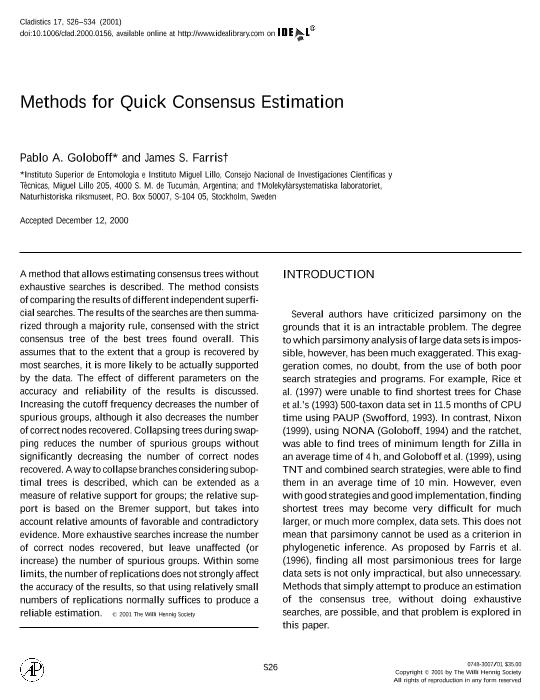Mostrar el registro sencillo del ítem
dc.contributor.author
Goloboff, Pablo Augusto

dc.contributor.author
Farris, James S.
dc.date.available
2019-07-04T13:52:58Z
dc.date.issued
2001-12
dc.identifier.citation
Goloboff, Pablo Augusto; Farris, James S.; Methods for quick consensus estimation; Wiley Blackwell Publishing, Inc; Cladistics; 17; 1; 12-2001; 26-34
dc.identifier.issn
0748-3007
dc.identifier.uri
http://hdl.handle.net/11336/79109
dc.description.abstract
A method that allows estimating consensus trees without exhaustive searches is described. The method consists of comparing the results of different independent superficial searches. The results of the searches are then summarized through a majority rule, consensed with the strict consensus tree of the best trees found overall. This assumes that to the extent that a group is recovered by most searches, it is more likely to be actually supported by the data. The effect of different parameters on the accuracy and reliability of the results is discussed. Increasing the cutoff frequency decreases the number of spurious groups, although it also decreases the number of correct nodes recovered. Collapsing trees during swapping reduces the number of spurious groups without significantly decreasing the number of correct nodes recovered. A way to collapse branches considering suboptimal trees is described, which can be extended as a measure of relative support for groups; the relative support is based on the Bremer support, but takes into account relative amounts of favorable and contradictory evidence. More exhaustive searches increase the number of correct nodes recovered, but leave unaffected (or increase) the number of spurious groups. Within some limits, the number of replications does not strongly affect the accuracy of the results, so that using relatively small numbers of replications normally suffices to produce a reliable estimation. © The Willi Hennig Society.
dc.format
application/pdf
dc.language.iso
eng
dc.publisher
Wiley Blackwell Publishing, Inc

dc.rights
info:eu-repo/semantics/openAccess
dc.rights.uri
https://creativecommons.org/licenses/by-nc-sa/2.5/ar/
dc.subject
Consensus Trees
dc.subject
Independent Superficial Searches
dc.subject
Majority Rule
dc.subject
Accuracy And Realiability
dc.subject.classification
Biología

dc.subject.classification
Ciencias Biológicas

dc.subject.classification
CIENCIAS NATURALES Y EXACTAS

dc.title
Methods for quick consensus estimation
dc.type
info:eu-repo/semantics/article
dc.type
info:ar-repo/semantics/artículo
dc.type
info:eu-repo/semantics/publishedVersion
dc.date.updated
2019-06-14T15:19:00Z
dc.journal.volume
17
dc.journal.number
1
dc.journal.pagination
26-34
dc.journal.pais
Reino Unido

dc.journal.ciudad
Londres
dc.description.fil
Fil: Goloboff, Pablo Augusto. Consejo Nacional de Investigaciones Científicas y Técnicas. Centro Científico Tecnológico Conicet - Tucumán; Argentina. Universidad Nacional de Tucuman. Facultad de Ciencias Naturales e Instituto Miguel Lillo. Instituto Miguel Lillo; Argentina
dc.description.fil
Fil: Farris, James S.. Naturhistoriska Riksmuseet; Suecia
dc.journal.title
Cladistics

dc.relation.alternativeid
info:eu-repo/semantics/altIdentifier/doi/https://dx.doi.org/10.1006/clad.2000.0156
dc.relation.alternativeid
info:eu-repo/semantics/altIdentifier/url/https://onlinelibrary.wiley.com/doi/abs/10.1111/j.1096-0031.2001.tb00102.x
Archivos asociados
